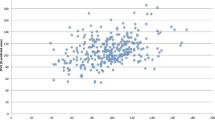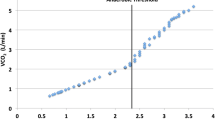Abstract
Cardiopulmonary exercise testing (CPET) in paediatric cardiology differs in many aspects from the tests performed in adult cardiology. Children's cardiovascular responses during exercise testing present different characteristics, particularly oxygen uptake, heart rate and blood pressure response, which are essential in interpreting haemodynamic data. Diseases that are associated with myocardial ischaemia are rare in children. The main indications for CPET in children are evaluation of exercise capacity and the identification of exercise-induced arrhythmias. In this article we will review the main indications for CPET in children with congenital heart disease, the contraindications for exercise testing and the indications for terminating an exercise test. Moreover, we will address the interpretation of gas exchange data from CPET in children with congenital heart disease. (Neth Heart J 2009;17:385–92.)
Similar content being viewed by others
References
Connuck DM. The role of exercise stress testing in pediatric patients with heart disease. Pediatr Cardiol. 2005;20:45–52.
Bar-Or O. Pathophysiological factors which limit the exercise capacity of the sick child. Med Sci Sports Exerc. 1986;18:276–82.
Lunt D, Briffa T, Briffa NK, Ramsay J. Physical activity levels of adolescents with congenital heart disease. Aust J Physiother. 2003; 49:43–50.
Rich MW. Heart failure disease management: a critical review. J Card Fail. 1999;5:64–75.
Alpert BS, Verrill DE, Flood NL, Boineau JP, Strong WB. Complications of ergometer exercise in children. Pediatr Cardiol. 1983; 4:91–6.
Stephens P Jr, Paridon SM. Exercise testing in pediatrics. Pediatr Clin North Am. 2004;51:1569–87, viii.
Rodgers GP, Ayanian JZ, Balady G, Beasley JW, Brown KA, Gervino EV, et al. American College of Cardiology/American Heart Association Clinical Competence Statement on Stress Testing. A Report of the American College of Cardiology/American Heart Association/American College of Physicians-American Society of Internal Medicine Task Force on Clinical Competence. Circulation. 2000;102:1726–38.
Pelliccia A, Fagard R, Bjornstad HH, Anastassakis A, Arbustini E, Assanelli D, et al. Recommendations for competitive sports participation in athletes with cardiovascular disease: a consensus document from the Study Group of Sports Cardiology of the Working Group of Cardiac Rehabilitation and Exercise Physiology and the Working Group of Myocardial and Pericardial Diseases of the European Society of Cardiology. Eur Heart J. 2005;26:1422–45.
Taylor CB, Bandura A, Ewart CK, Miller NH, DeBusk RF. Exercise testing to enhance wives' confidence in their husbands' cardiac capability soon after clinically uncomplicated acute myocardial infarction. Am J Cardiol. 1985;55:635–8.
Moalla W, Gauthier R, Maingourd Y, Ahmaidi S. Six-minute walking test to assess exercise tolerance and cardiorespiratory responses during training program in children with congenital heart disease. Int J Sports Med. 2005;26:756–62.
Bar-Or O. Pediatric sports medicine for the practitioner. New York: Springer-Verlag; 1983.
Shephard RJ, Allen C, Benade AJ, Davies CT, Di Prampero PE, Hedman R, et al. The maximum oxygen intake. An international reference standard of cardiorespiratory fitness. Bull World Health Organ. 1968;38:757–64.
Hill AV, Lupton H. Muscular exercise, lactic acid and the supply and utilization of oxygen. Q J Med. 1923;16:135–71.
Howley ET, Bassett DRJ, Welch HG. Criteria for maximal oxygen uptake: review and commentary. Med Sci Sports Exerc. 1995;27: 1292–301.
Rowland TW. Does peak VO2 reflect VO2max in children?: evidence from supramaximal testing. Med Sci Sports Exerc. 1993; 25:689–93.
Armstrong N, Welsman J, Winsley R. Is peak VO2 a maximal index of children's aerobic fitness? Int J Sports Med. 1996;17: 356–9.
Fick A. Ueber die Messung des Blutquantums in den Herzventrikeln. Sitx Physik-Med Ges Wurzburg. 1870;2:16.
Shephard RJ, Allen C, Benade AJ, Davies CT, Di Prampero PE, Hedman R, et al. The maximum oxygen intake. An international reference standard of cardiorespiratory fitness. Bull World Health Organ. 1968;38:757–64.
Haller RG, Lewis SF, Cook JD, Blomqvist CG. Hyperkinetic circulation during exercise in neuromuscular disease. Neurology. 1983;33:1283–7.
Taylor HL, Buskirk E, Henschel A. Maximal oxygen intake as an objective measure of cardiorespiratory performance. J Appl Physiol. 1955;8:73–80.
Franklin BA. Abnormal cardiorespiratory responses to acute aerobic exercise. In: Roitman JL, editor. ACSM's resource manual for guidelines for exercise testing and prescription. Third edition. Baltimore: Williams and Wilkins; 1998. p. 146–55.
Rowland TW. Aerobic exercise testing protocols. In: Rowland TW, editor. Pediatric Laboratory Exercise Testing: Clinical Guidelines. Champaign, Ill: Human Kinetics; 1993. p. 19–41.
Cooper DM, Weiler-Ravell D, Whipp BJ, Wasserman K. Aerobic parameters of exercise as a function of body size during growth in children. J Appl Physiol. 1984;56:628–34.
Astrand PO. Experimental studies of physical work capacity in relation to sex and age: Copenhagen, Munkgaard; 1952.
Owens S, Gutin B. Exercise testing of the child with obesity. Pediatr Cardiol. 1999;20:79–83.
Tanner JM. Fallacy of per weight and per surface area standards and their relation to spurius correlation. J Appl Physiol. 1949;2: 1–15.
Schmidt-Nielsen K. Scaling: Why is animal size so important? Cambridge: Cambridge University Press; 1984.
Weibel ER, Hoppeler H. Exercise-induced maximal metabolic rate scales with muscle aerobic capacity. J Exp Biol. 2005;208: 1635–44.
Hermansen L, Ekblom B, Saltin B. Cardiac output during submaximal and maximal treadmill and bicycle exercise. J Appl Physiol. 1970;29:82–6.
Hermansen L, Saltin B. Oxygen uptake during maximal treadmill and bicycle exercise. J Appl Physiol. 1969;26:31–7.
Astrand P, Rodahl K, Astrand PRK. Textbook of work physiology, physiological bases of exercise. New York: McGraw-Hill Book Company; 1986.
Ohuchi H. Cardiopulmonary response to exercise in patients with the Fontan Circulation. Cardiol Young. 2005;15 Suppl 3:39–44.
McManus A, Leung M. Maximising the clinical use of exercise gaseous exchange testing in children with repaired cyanotic congenital heart defects: the development of an appropriate test strategy. Sports Med. 2000;29:229–44.
Singh TP, Rhodes J, Gauvreau K. Determinants of heart rate recovery following exercise in children. Med Sci Sports Exerc. 2008;40:601–5.
Singh TP, Curran TJ, Rhodes J. Cardiac rehabilitation improves heart rate recovery following peak exercise in children with repaired congenital heart disease. Pediatr Cardiol. 2007;28:276–9.
Godfrey S. Exercise testing in children. London: W.B. Saunders Company Ltd.; 1974.
Driscoll DJ, Staats BA, Beck KC. Measurement of Cardiac Output in Children During Exercise: A Review. Pediatr Exerc Sci. 1989;1: 102–15.
Baba R, Nagashima M, Nagano Y, Ikoma M, Nishibata K. Role of the oxygen uptake efficiency slope in evaluating exercise tolerance. Arch Dis Child. 1999;81:73–5.
Baba R, Nagashima M, Goto M, Nagano Y, Yokota M, Tauchi N, et al. Oxygen uptake efficiency slope: a new index of cardiorespiratory functional reserve derived from the relation between oxygen uptake and minute ventilation during incremental exercise. J Am Coll Cardiol. 1996;28:1567–72.
Marinov B, Mandadzhieva S, Kostianev S. Oxygen-uptake efficiency slope in healthy 7- to 18-year-old children. Pediatr Exerc Sci. 2007;19:159–70.
Groen WG, Hulzebos EH, Helders PJ, Takken, T. Oxygen Uptake To Work Rate Relationship During Exercise In Children With Lung, Heart or Muscle Disease. Med Sci Sports Exerc. 2009;41:S5, Abstract 1658.
Hansen JE, Sue DY, Oren A, Wasserman K. Relation of oxygen uptake to work rate in normal men and men with circulatory disorders. Am J Cardiol. 1987;59:669–74.
Wasserman K, Hansen JE, Sue DY, Casaburi R, Whipp BJ. Principles of Exercise Testing and Interpretation. Baltimore, MD: Lippincott, Williams and Wilkins; 1999.
Rhodes J, Geggel RL, Marx GR, Bevilacqua L, Dambach YB, Hijazi ZM. Excessive anaerobic metabolism during exercise after repair of aortic coarctation. J Pediatr. 1997;131:210–4.
Eschenbacher WL, Mannina A. An algorithm for the interpretation of cardiopulmonary exercise tests. Chest. 1990;97:263–7.
Riopel DA, Taylor AB, Hohn AR. Blood pressure, heart rate, pressure-rate product and electrocardiographic changes in healthy children during treadmill exercise. Am J Cardiol. 1979;44:697–704.
Rowell LB, O'Leary DS. Reflex control of the circulation during exercise: chemoreflexes and mechanoreflexes. J Appl Physiol. 1990; 69:407–18.
Turley KR, Wilmore JH. Cardiovascular responses to treadmill and cycle ergometer exercise in children and adults. J Appl Physiol. 1997;83:948–57.
Reybrouck T, Rogers R, Weymans M, Dumoulin M, Vanhove M, Daenen W, et al. Serial cardiorespiratory exercise testing in patients with congenital heart disease. Eur J Pediatr. 1995;154:801–6.
De Groot JF, Takken T, Schoenmakers MA, Vanhees L, Helders PJ. Limiting factors in peak oxygen uptake and the relationship with functional ambulation in ambulating children with Spina Bifida. Eur J Appl Physiol. 2008;104:657–65.
Author information
Authors and Affiliations
Corresponding author
Additional information
Child development exercise center, Wilhelmina Children's Hospital, UMC Utrecht, Utrecht, the Netherlands.
Department of Paediatric Cardiology, Wilhelmina Children's Hospital, UMC Utrecht, Utrecht, the Netherlands
T. Takken Department of Paediatric Physical Therapy & Exercise Physiology, Wilhelmina Children's Hospital, University Medical Center Utrecht, Room KB02.056.0, PO Box 85090, 3508 AB Utrecht, the Netherlands
Rights and permissions
About this article
Cite this article
Takken, T., Blank, A.C., Hulzebos, E.H. et al. Cardiopulmonary exercise testing in congenital heart disease: (contra)indications and interpretation. NHJL 17, 385–392 (2009). https://doi.org/10.1007/BF03086289
Issue Date:
DOI: https://doi.org/10.1007/BF03086289




